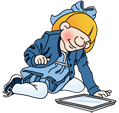The teaching of English and Welsh embraces all aspects of language, both spoken and written. In order to communicate effectively, children need to be confident both orally and in the written word and be able to read a wide range of different texts. At Cradoc we view the acquisition of language skills as very important and it is given a high priority.
We believe that bilingualism provides a firm basis for learning all language skills and pupils at Cradoc School are supported the developing high levels of literacy in both English and Welsh (as a second language). Pupils who have learnt two languages at an early age will already have encountered important linguistic concepts, such as gender and word order, which will make them more receptive to different language structures in their life-long learning journey.
Both English and Welsh will be used to develop thinking skills by exploring, planning, developing and reflecting on ideas through speech, reading, writing, and responding o their own work as well as that of others. They acquire the skills to analyse, structure and organise their work, use language creatively, use errors and unexpected outcomes to develop their learning, use their knowledge about language to explain and predict, describe links and similarities in language, identify patterns and formulate rules, discuss their language learning and evaluate their success. This all contributes to pupils becoming dynamic and flexible learners.
Communication skills are developed through speaking, listening, reading and writing, developing these skills through appraisal of their own work and that of others. In doing so, pupils learn how to communicate effectively for a range of purposes and with a range of audiences. They will deal with extended and increasingly complex language in order to develop as independent and confident users.
- Oracy
- Reading
- Writing
- Literature
- Spelling
- Phonics
- Digital Communication
- Modern Foreign Languages
The Digital Competency Framework supports the development of literacy skills using ICT skills across the curriculum by finding, developing, creating and presenting information and ideas, using a wide range of available equipment and software. They will communicate and share information using technology to research, develop and present their work. This includes the use of j2e, Hwb and Office 360.
The Literacy and Numeracy Framework supports the development of number skills in literacy work across the curriculum by using mathematical information, calculating and interpreting and presenting findings. Activities might include number rhymes, ordering events in time, gathering information in a variety of ways, such as questionnaires, accessing, selecting, recording and presenting data in a range of formats including report writing.









